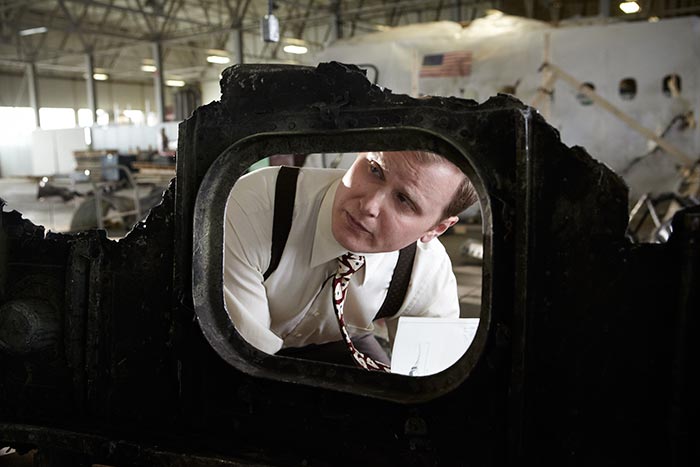It was not a single horrible incident that triggered my fear of flying. It was a gradual accumulation of minor, uncomfortable episodes that have hardened, like plaque, into an unyielding anxiety. While working out of Yellowknife as a journalist, there were too many unsettling Arctic flights, bumping through thick weather, or onto crude gravel runways. There was an attempted landing through a thunderstorm in Montreal, when I pressed my face into the chest of my blessedly calm seatmate, who cradled me as we were tossed around inside black clouds before detouring to Ottawa. There was an overseas flight that made an emergency landing in Goose Bay, Newfoundland, after a chemical odour filled the cabin. (We later learned that a passenger had spat medicated mouthwash into the lavatory sink, and the fumes had seeped into the ventilation system.) Add to this that I come from a family of worriers, who have handed down an alarmist mentality with a default setting to worst case.
The possibility of crashing is the overriding, though distant, factor in my unease. It is all of my other anxieties—enclosed spaces, loss of control, inability to flee, potential proximity to vomit—brought together in the cauldron of an airplane. Before boarding, I always glance around the lounge, wondering if others are sitting in a cloud of private torture. If the 9/11 attacks did not kick up fear and paranoia among the calmest flyers, the resulting security and surveillance measures have, at the very least, made the process more stressful. According to a widely cited American study commissioned by Boeing in 1980, one in six adults is afraid of flying. It remains the most expansive survey of its kind, and I imagine the ratio still holds today, despite advances in aviation safety. After all, planes still crash.
The Canadian TV series Mayday is a platter of these crashes. A simple winning premise underlies the show: dramatizations of actual flight disasters and their investigations, coupled with documentary-style interviews with survivors, families of victims, and industry experts. Since 2003, the program has covered more than 100 incidents, ranging from headline makers, like Swissair Flight 111’s fiery drop into the Atlantic in 1998, and US Airways’ dramatic Hudson River landing four years ago; to obscure crashes involving cargo or military planes; to truly confounding cases, like the chilling dive into the sea by Air France Flight 447 off the coast of Brazil in 2009. The show airs in 170 countries in thirty-eight languages (under the name Air Crash Investigation), sucking in phobics like me, as well as aviation nerds and everyone in between, with horrors we all hope we will never have to face. So why, then, do we watch?
When I visit Mayday’s Toronto studio in March, the crew is filming an episode for season thirteen, which will air in Canada next winter. Today they are recreating the cockpit scenes for the 1971 collision of a DC-9 Hughes Airwest passenger plane and a US Marine Corps F-4 Phantom II fighter jet 15,150 feet above southern California. Christopher Russell plays Lieutenant Christopher Schiess, the twenty-four-year-old radar officer on the Phantom and the only survivor. He is suited up in an ejector seat in front of a blue screen, and he mimes the motions being called out by first assistant director Michael Sinyi, who also happens to be a pilot in training. (This is a TV crew of plane enthusiasts.) “Check your instruments,” Sinyi shouts. “Okay, now look out the window, back at the instruments. Okay, you’re starting to feel woozy, roll your eyes, okay, good!” The fighter jet had a slight oxygen leak and, more importantly, a broken radar transponder, so air traffic control didn’t know it was in the busy airspace over Los Angeles. It was up to the pilot to see and be seen.
A metre or two from the blue screen, the DC-9 cockpit is set in a permanent wood-framed structure that houses the cockpit interiors for the show. Stepping inside, it feels momentarily real. The pilots, played by Doug MacLeod and Rick Hughes, are being coached in cockpit choreography by Dave Dawson, a veteran Air Canada captain who ensures that the actors look, talk, and move as pilots would under the circumstances. In this case, the Phantom’s tail fin sliced through the DC-9 cockpit on the pilot’s side, likely ripping it from the cabin before the whole mess smashed into a valley, killing all forty-nine people on board. Schiess managed to eject from the F-4 and emerged unharmed, but the pilot, First Lieutenant James Phillips, could not release his seat in time and went down with the jet.
The scene with the DC-9 passengers was shot the day before. As with the cockpit, the interior of a constructed fuselage is dressed for each episode. Inside, it is littered with debris from yesterday’s shoot. The seats have ashtrays in the armrests, and there is a vintage National Geographic in one of the seat pockets, along with a barf bag. Just standing there makes me shudder. En route to Seattle, the DC-9 had barely cleared LA when the fighter jet struck it. If the fuselage did, in fact, split from the cockpit, the passengers—some still strapped in to their seats—likely pancaked straight down into the San Gabriel Mountains. How many seconds did it take? Did they have time to consider the horror? Were people screaming, or was it quiet? I can’t get those final moments out of my head.
Iam surprised at my willingness to watch a show that animates my deepest terror. According to Tom Bunn, a retired commercial pilot and therapist who has treated fearful flyers for more than thirty years, people like me are drawn to air disaster shows. “It’s an attempt at control,” he says over the phone from his home in Connecticut. “Anxious flyers want to figure out what would happen to them physically and psychologically [in a plane crash], to decide what they could do in that situation.” So on some level, watching Mayday is my attempt to get a handle on what disaster feels like. But there is also a sick compulsion to nourish my fear: I want to see the cabin terror scenes; I ask to hear peoples’ bad flight stories.
At its core, Mayday is gripping television for anyone, fearful flyer or not, because it feeds a long-standing fascination with catastrophes on a spectacular scale. Disaster as entertainment dates back to the silent film era, and the genre came to reflect the concerns of the day, whether it was nuclear devastation and natural calamities, or terrorism and pandemics. The 1970 film Airport centred on the havoc caused by a suicide bomber on an airliner. Critically panned but a box-office hit, it spawned three sequels and was credited with restyling the modern disaster film through heightened special effects and nuanced human drama. Today disaster is standard fodder for television and movies—three big-budget productions coming out this year mine post-apocalyptic scenarios—while advances in computer-generated imagery have made the stories at once more outlandish and more realistic.
Beyond drawing on viewers’ morbid rubbernecking, the genre taps in to a fundamental collective unease about the fragility of humankind, and the fantasy of our ultimate perseverance. Think of 1998’s Armageddon, in which a ragtag space shuttle crew destroys an asteroid moments before it’s about to hit Earth; or the more grounded Contagion, from 2011, about scientists who thwart a lethal flu pandemic. These empowering fairy tales deliver a muscle-flexing-in-the-mirror bravado, while TV shows such as Surviving Disaster and Survivorman give tips on how to live through a mall shooting or being lost at sea.
Mayday’s appeal is similarly rooted in the tension of survival in the bleakest, most vulnerable circumstances. The show’s co-creator, André Barro, came up with the idea in the spring of 2001 on a flight from Paris, after his friend and fellow TV producer Bernard Vaillot handed him a book called Le secret des boîtes noires (The Secret of the Black Boxes), a compendium of cockpit voice recorder transcripts. Concealing the cover from the other passengers, Barro spent the flight engrossed in the unique drama of pilots battling to save themselves, their passengers, and their crews. “There is something powerful about that, about what is done under those terrible circumstances to save lives,” Barro says from Montreal, where he is now an executive producer with Handel Productions (he left Mayday after its fifth season).
In its early years, Mayday competed with an American series called Seconds from Disaster, which recreated the gamut of calamities: earthquakes, terrorist attacks, and space shuttle explosions, as well as aircraft and train crashes. Mayday’s producers experimented with a more inclusive format, and in the third season depicted two train accidents and the sinking of a passenger ferry. But Barro felt these episodes, though tragic and compelling, lacked the resonance and mystique of ones that featured planes. “There is something about flying—even if you’re not afraid of it,” he says. “We used to say at the end of every show that flying is still the safest way to travel. That’s still true, but when disaster happens it’s spectacular, and everyone on the planet knows about it.”
Unless you follow aviation news, you often don’t know how and why a plane went down. Most of us find the systems involved in flying an aircraft mysterious and unknowable, a black hole where fear easily festers. Watching investigations play out on Mayday, I realize how many glitches have to occur to cause an emergency (experts refer to these as chains of events), and how low the probability turns out to be. In the end, these tedious and tireless reviews often prompt important changes in regulations and manufacturing.
The runway collision of two Boeing 747s in 1977, on Tenerife in the Canary Islands, remains the deadliest aviation disaster in history: 583 people were killed. It inspired changes in how pilots communicate with air traffic control, and it revolutionized the culture of decision-making in the cockpit. In 1982, the four-engine failure of British Airways Flight 009 over a volcano near Jakarta illuminated the dangers of volcanic ash; and the 1998 investigation into Swissair Flight 111 resulted in better flammability standards for aircraft components. In 2000, Boeing re-engineered the 737’s rudder control system to address safety concerns that came to light following two crashes in the early 1990s. Taken together, the lessons gleaned from air disasters have made flying the safest it has been since 1945, before commercial jetliners took to the skies. Yet any comfort I derive from cold statistics is instantly dispelled whenever a plane overshoots a runway, or loses an engine, or hurtles into a mountain.
On the final day of shooting, the Mayday crew has moved to a warehouse in nearby Brantford, Ontario, to stage the investigation scenes. A ragged piece of the DC-9 fuselage has been constructed out of plastic sheeting blackened with a blowtorch to look fire damaged. The actor playing one of the National Transportation Safety Board investigators walks amid the scattered parts, scribbling in a notebook. He notices a smudge of grey paint on the DC-9’s skin, a finding that helped determine how the planes collided. The investigators would eventually learn that the two aircraft had been careening toward each other at the speed of a .45 calibre bullet—no chance for the pilots to even consider a crash. But here I am, over forty years later, still considering, reliving, and anguishing over it.
The Walrus thanks the Writers’ Trust of Canada for its financial support of this story.
This appeared in the July/August 2013 issue.





